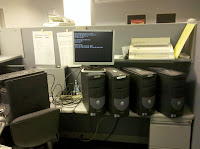I've been a Microsoft guy since DOS 5. I've used every version of Windows since 3.1. So, how did a Microsoft fan-boy get into Linux? It's a long story.
 When I went back to school (after a short 15 year break), I took an operating systems class at WV State College. This was way back in the distant past(circa 2005.) One of our tasks was to install the Fedora Core 4 operating system. We must have installed that thing at least ten times.
When I went back to school (after a short 15 year break), I took an operating systems class at WV State College. This was way back in the distant past(circa 2005.) One of our tasks was to install the Fedora Core 4 operating system. We must have installed that thing at least ten times.Anyway, I was intrigued. Linux was exotic and novel. I guess it spoke to my inner geek. But, I was a happy Windows user.
 |
| Using Linux to wipe computers |
I will admit that this first experience with Linux was not at all pleasant. I was a very seasoned computer user, but everything I knew was suddenly obsolete. Where were my drive letters? How did I install programs? Where did my Documents and Settings folder go? I lasted maybe a month. The final straw was trying to connect a local laser printer. After I attempted, in vain, to configure the CUPS driver, I finally gave up. I bought a large hard drive, and reinstalled Windows.
Still, the siren song of Linux called to me. I really enjoyed most other open source programs. I used GCC in my C++ classes. I fell into love with GIMP. I even installed TuxPaint for my daughter.
Then I upgraded my computer. It had a dual core, 64 bit processor, with 4 gig Ram. But, good old Windows XP Pro was a 32 bit operating system. That meant I couldn't use the hardware to its fullest advantage. On top of that, 32 bit Windows can only access about 3 1/2 Gigs of RAM.
Since I plunked down over $100 for pro version of XP, I thought I might be able to upgrade to the 64 bit version for free. Ha! Microsoft give something away? Not only would I have to spend another $100 for it, but most of my software wouldn't work on it.
So, I wondered, what would it be like computing at 64 bits? On a lark, I downloaded the 64 bit version of Ubuntu 10.10.
Sure, it still took a bit to figure out where stuff went, but it was so fast and easy that I still haven't gone back.
I still use Windows every day, but I can now proudly state that I am a Linux user.

